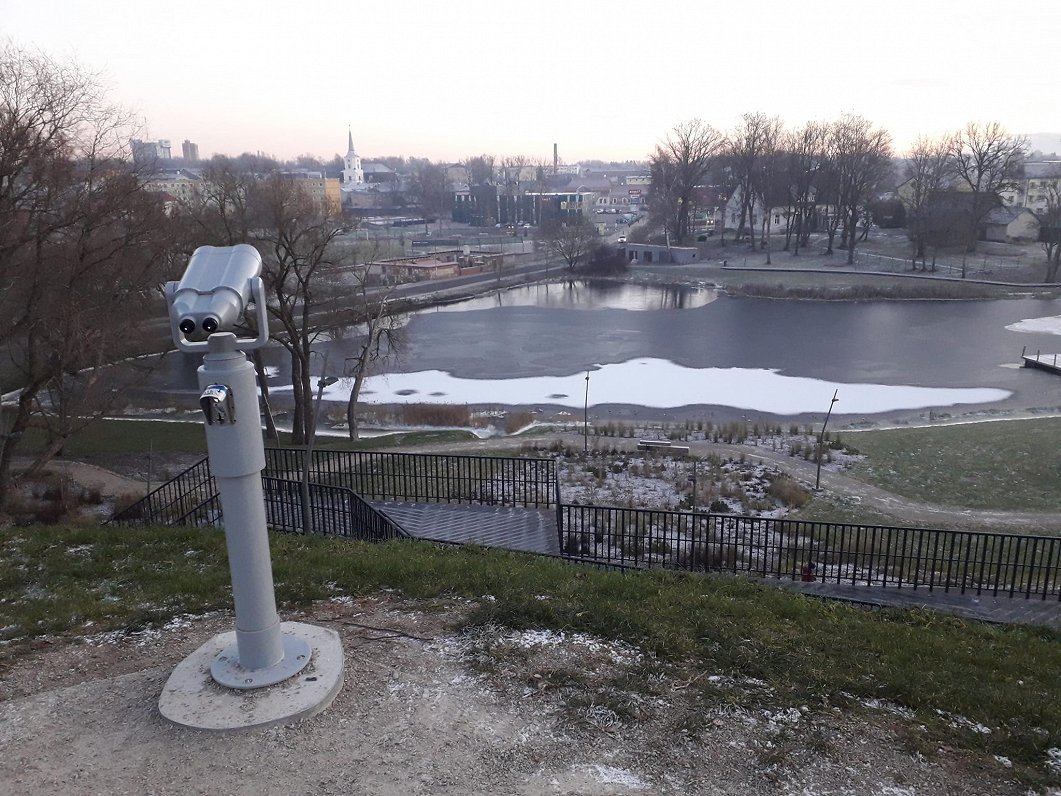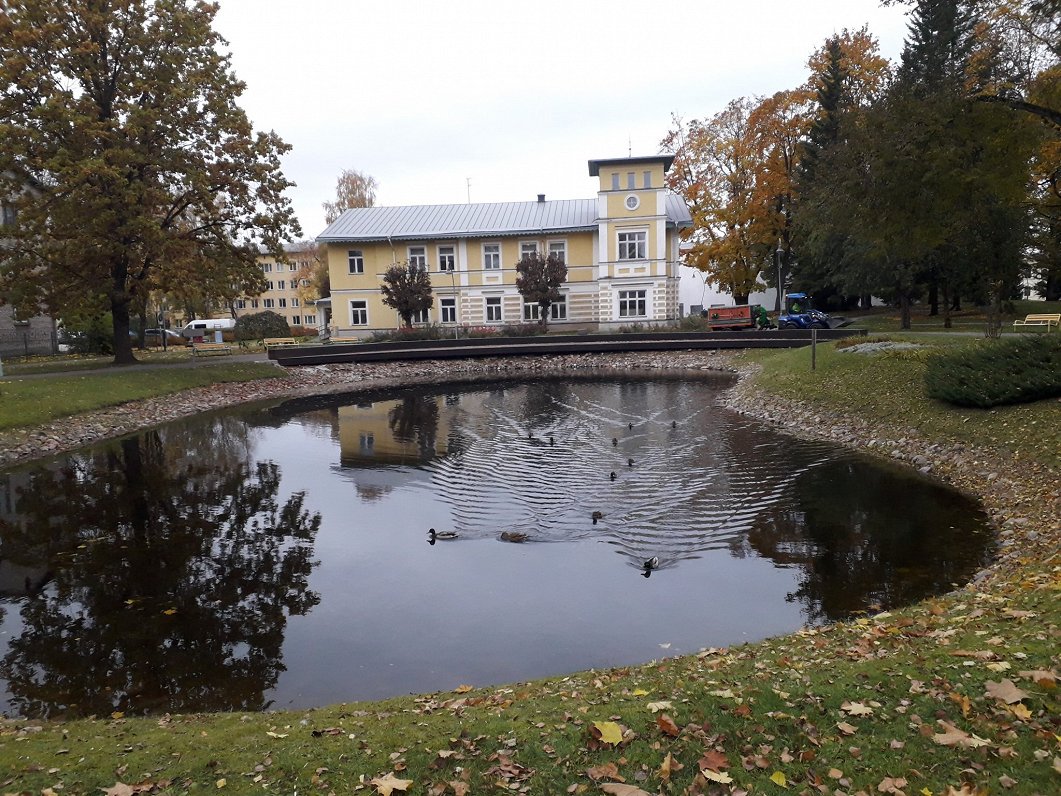Let's start in the most obvious place – or places. The twin town – or towns – of Valka (Latvia) and Valga (Estonia). Until 1920 it was certainly a single city, with the German name 'Walk'. Estonia and Latvia both became independent in 1918, and both claimed Walk as their own, though fighting in the Latvian and Estonian wars of independence continued into 1920.
Eventually an international commission headed by British civil servant Stephen George Tallents was to decide who got the city. According to the most entertaining account of what ensued, Tallents got so fed up with the constant bickering of both parties he ended up drawing a line on a map along the Varžupīte/Konnaoja, an innocuous little stream that ran through Walk, and declared that henceforth it would be the international border, with Valga on the north side and Valka on the south side. Ironically, Tallents later went on to found the Institute of Public Relations.
During the Soviet occupation of both countries, the stream was allowed to return to obscurity, only for renewed independence to make it a sort of miniature Livonian Rubicon again, and then for the Schengen Agreement to send it into well-earned retirement, hopefully for good.
You cannot help picking up a certain amount of history when you regularly visit somewhere, and each visit to Walk tends to reveal something new about Latvian-Estonian relations. There are the buildings that used to house Latvian associations that are now in Estonia. There is the discreet monument to the Finnish 'Northern Boys' (Pohjan Pojat) volunteers with their bear's head badge on the side of St John's church. One of the more uncomfortable facts is that 28 Finns were killed at the Battle of Paju in January 1919 defending Estonian independence against the pro-Soviet Latvian Red Riflemen. The Finns also distinguished themselves on Latvian territory in the liberation of Alūksne from the Soviets. A memorial hill stands by the side of the highway close to the scene of the Paju battle on the road from Valga to Tartu.

A similarly-sized hill stands in the recently constructed cross-border park along the banks of the River Pedele/Pedeli in Valka. There on top of 'Porridge Hill' (Putraskalns/Pudrumägi) in Latvia it is a literal stone's throw to the border below. If you did throw that stone – or a bowl of porridge – it would land close to a shopping centers on Estonian territory. I recall seeing a woman standng outside it center last year busking by singing Latvian folk songs. She seemed to have a fairly appreciative foreign audience on her impromptu international tour.
On the Latvian side of the border are a few shops selling cheap alcohol, and the tendency of Estonians and Finns to cross the border and fill their cars with bottles is well recorded. But less well-known is the fact that Latvia charges duty on coffee, while Estonia does not. So there is a less-well-known trend of Latvians wandering across to buy a few cheap packets of a different drug.
Helpfully, as well as exercise equipment, Putraskalns hill is equipped with a pair of powerful binoculars which are free to use, though the general direction in which they are pointed suggests they might be there so you can examine Estonian apartment blocks to see if anyone has left their curtains open while they wander around in their underwear.

The experience of geographical difference between the Latvian and Estonian sides of the border is one thing, but it can be greatly enhanced by what we might call temporal difference. For example I was recently in the twin cities when it was a public holiday in Latvia but an ordinary working day in Estonia. It was as if the two towns drifted slightly further apart for the day. Similarly, when there were election posters prominent on the Estonian side but there were no elections happening in Latvia, it felt as if Estonia's political parties were shouting into a void.
It is also worth mentioning my two favourite places to eat: Walk Cafe on the Latvian side (lunchtime special is the best value in the whole country and a good place to eavesdrop local business deals) and Kohvik Johanna on the Estonian side which contains everything I consider necessary in a really good cafe: excellent coffee, fresh poppy seed cakes, studious young men reading books and elegant old ladies in berets.
My routine when visiting Valka/Valga/Walk is always the same, and for a very simple reason. I catch the 12:33 train from Cēsis in Latvia which arrives in Valga (the only station is a couple of hundred meters across the border) at 13:42. The station is quite grand – oversized, in fact – but there's no time to waste. I walk as quickly as possible the 500 meters to Säde park, sit on a bench and feed the ducks. For a few minutes I have the appearance of being just another anonymous, middle-aged Estonian man on his lunch break. Little do they suspect that in fact I am an international traveller who has just just crossed the border and who is treating everything around me as different and exotic.

By preference I choose one of the benches brightly painted with folk motifs, unless I am in a retro mood, in which case the clunky 1980s-style ones will suffice. At one end of the duck pond is an attractive villa, its half-new, half-old form very much suiting a city infused with duality. The older part was a villa built in 1902 for an entrepreneurial local wonderfully named Gotthold Eduard Emil Zencker. During the Estonian war of independence the Latvian Red Cross ran a soup kitchen from the building, and it later served more sinister purposes as headquarters for the Communist Party, NKVD, and occupying Nazi German forces as well as seeing service as an orphanage and youth center. Since 1996 it has been Valga Central Library. The building's own history is probably just as informative as the history section located within it.
A desire to catch a train in order to feed the ducks in another country may raise questions about my psychological well-being, but I see this little routine as therapeutic rather than pathologic. Indeed the character of the park itself tends to support my little pan-Baltic fantasy life.

Nearby in the park is a statue honoring 'Toomas Nipernaadi', a popular character in Estonian literature. Balanced on one leg, with his battered hat held aloft on a stick, he is an "eternal wanderer" who has all sorts of pointless and picaresque adventures. According to the information beside the statue, he is precisely the type who would approve of going to another country and sitting on a bench for no particular reason:
"He strode along the paths in the fields, picked flowers, whistled and was cheerful. There was something artistic and naive in his entire being. He gazed at clouds and became elated... thus he sat for several hours, lost in reverie."
Nipernaadi was the creation of August Gailit, an Estonian writer who – as is clear from his name (Gailītis is a common Latvian surname) – had Latvian ancestry. Born in 1891, he attended the Latvian school in Walk and later worked as a journalist in Latvia and as press attache at the Estonian embassy in Rīga.
If Gailit and Nipernaadi are allowed to wander around having Quixotic adventures, I don't see why the rest of us shouldn't be allowed to do the same.
But by now it is well past 14:30. I need to hurry to get back to the Valga railway station in time for the departure at 15:03 of exactly the same train which brought me up here. There isn't even time to buy packets of coffee.
Just outside the station is an information board giving details of another piece of delightful Latvian-Estonian absurdity.
"Due to setting of the national border between Estonia and Latvia after World War 1, the beginning of the railway line to Mõniste appeared to be in Latvia and large sums of money were demanded from Estonia. Thus a new railway line through Kaagjärve was constructed and trains to Mõniste did not pass Latvian territory."
And there it is, waiting for me in the shadow of the oversized station tower. It's my Latvian train departing from Estonia, my second international trip of the day. On the other platform is one of the sleek, super-modern, hi-tech trains for Tartu that the Estonians have amusingly nicknamed "carrots" due to their orange color.

My Latvian train is older, slower and louder than the state of the art carrot, but it's also a lot cheaper. The return ticket costs me a little over 5 euros. I can leave at lunchtime, cross an international border twice, consume a poppy seed cake and a considerable slice of Baltic history and still be home in time for an early supper. It is proto-Rail Baltica on a budget and it is just one of the attractions of the Estonian-Latvian border zone. More to come.































